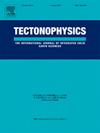Frictional properties of serpentine gouge under high pore-fluid pressure and low effective normal stress conditions
IF 2.6
3区 地球科学
Q2 GEOCHEMISTRY & GEOPHYSICS
引用次数: 0
Abstract
Serpentine minerals exist pervasively near the subduction mantle wedge. Due to their distinct physical and chemical properties, they have the potential to significantly impact the frictional behavior and stability of subduction fault zones. Here we investigated the frictional properties of an antigorite-lizardite mixture gouge under hydrothermal conditions with an effective normal stress of 30 MPa, a pore fluid pressure of 100 MPa, and temperatures ranging from 100 °C to 500 °C. To explore the velocity dependence of frictional strength, the loading rate is switched between 0.04, 0.2, and 1.0 μm/s. The results show that the friction coefficient of the gouge decreases systematically with temperature, with values ranging from 0.75 to 0.36. The thermal weakening of the gouge friction can be attributed to enhanced intergranular pressure solution processes activated at the relatively high fluid pressure. Stable velocity-strengthening behavior was observed in most cases. However, velocity-weakening behavior, evidenced by sustained oscillation, was found at 300 °C and 400 °C at the slowest loading rate (0.04 μm/s), with a transition to velocity-strengthening behavior at higher loading rates. Our results further suggest that, under the high pore fluid pressure and temperature conditions characteristic of the subduction zone mantle wedge, the nucleation of unstable slip at low slip rates can decelerate as fault slip accelerates into the velocity-strengthening regime, ultimately terminating as a slow-slip event. These insights contribute to a better understanding of the processes underlying slow slip events in subduction zones.
高孔隙流体压力和低有效法向应力条件下蛇纹石泥的摩擦特性
蛇纹岩矿物普遍存在于俯冲地幔楔附近。由于其独特的物理和化学性质,它们有可能显著影响俯冲断裂带的摩擦行为和稳定性。在有效法向应力为30 MPa,孔隙流体压力为100 MPa,温度范围为100 °C ~ 500 °C的热液条件下,研究了反长辉石岩-蜥蜴石混合泥的摩擦特性。为了探索摩擦强度与速度的关系,加载速率在0.04、0.2和1.0 μm/s之间切换。结果表明:泥的摩擦系数随温度的升高有系统的降低,其值在0.75 ~ 0.36之间;断层泥摩擦的热减弱可归因于在较高流体压力下激活的颗粒间压力溶解过程的增强。在大多数情况下观察到稳定的速度强化行为。然而,在300 °C和400 °C时,以最慢加载速率(0.04 μm/s)发现了持续振荡的速度减弱行为,并在更高加载速率下过渡到速度增强行为。研究结果进一步表明,在俯冲带地幔楔的高孔隙流体压力和温度条件下,低滑动速率下的不稳定滑动的成核可以随着断层滑动加速进入速度强化区而减速,最终以慢滑动事件结束。这些见解有助于更好地理解俯冲带慢滑事件背后的过程。
本文章由计算机程序翻译,如有差异,请以英文原文为准。
求助全文
约1分钟内获得全文
求助全文
来源期刊

Tectonophysics
地学-地球化学与地球物理
CiteScore
4.90
自引率
6.90%
发文量
300
审稿时长
6 months
期刊介绍:
The prime focus of Tectonophysics will be high-impact original research and reviews in the fields of kinematics, structure, composition, and dynamics of the solid arth at all scales. Tectonophysics particularly encourages submission of papers based on the integration of a multitude of geophysical, geological, geochemical, geodynamic, and geotectonic methods
 求助内容:
求助内容: 应助结果提醒方式:
应助结果提醒方式:


